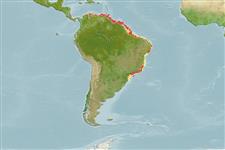>
Clupeiformes (Herrings) >
Pristigasteridae (Pristigasterids)
Etymology: Pellona: Derived from Latin, pellis = skin (Ref. 45335).
Eponymy: Dr David Elson Harrower (1890–1970) was a member of the Philadelphia Academy of Natural Science, with interests in both anthropology and zoology. [...] (Ref. 128868), visit book page.
More on author: Fowler.
Environment: milieu / climate zone / depth range / distribution range
Ecologia
marinhas; estuarina; intervalo de profundidade 5 - 36 m. Tropical; 12°N - 30°S, 89°W - 32°W (Ref. 188)
Western Atlantic: Panama, Trinidad, and the Guianas southward to southern Brazil.
Tamanho / Peso / Idade
Maturity: Lm ? range ? - ? cm
Max length : 18.0 cm TL macho/indeterminado; (Ref. 5217); common length : 12.0 cm TL macho/indeterminado; (Ref. 5217); peso máx. publicado: 33.00 g (Ref. 118626)
Espinhos dorsais (total) : 0; Raios dorsais (total) : 0; Espinhos anais: 0; Raios anais : 36 - 42. Belly with 17 to 20 + 5 to 7, total 22 to 26 scutes. Eye large, lower jaw projecting; upper jaw with a toothed hypo-maxillary bone between hind tip of pre-maxilla and lower bulge of maxilla blade. Pelvic fins with distinct axillary scale; anal fin long, its origin under middle of dorsal fin base. Scales easily lost (Ref. 188). Bluish gray above, sides silvery (Ref. 37032).
Found inshore, along beaches and down to at least 16 m over a muddy bottom. Enters estuaries, but perhaps not tolerating very low salinities (Ref. 12225).
Ciclo de vida ou comportamento de acasalamento
Maturidade | Reprodução | Desova | Ovos | Fecundidade | Larvas
Whitehead, P.J.P., 1985. FAO Species Catalogue. Vol. 7. Clupeoid fishes of the world (suborder Clupeoidei). An annotated and illustrated catalogue of the herrings, sardines, pilchards, sprats, shads, anchovies and wolf-herrings. FAO Fish. Synop. 125(7/1):1-303. Rome: FAO. (Ref. 188)
Status na Lista Vermelha da UICN (Ref. 130435: Version 2024-1)
Ameaça para os humanos
Harmless
Uso pelos humanos
Pescarias: pesca de subsistência
Ferramentas
Relatórios especiais
Baixar XML
Fontes da internet
Estimates based on models
Preferred temperature (Ref.
123201): 24.8 - 27.9, mean 27.3 °C (based on 82 cells).
Índice de diversidade filogenética (Ref.
82804): PD
50 = 0.5156 [Uniqueness, from 0.5 = low to 2.0 = high].
Bayesian length-weight: a=0.00794 (0.00663 - 0.00952), b=3.02 (2.97 - 3.07), in cm total length, based on LWR estimates for this species (Ref.
93245).
Nível Trófico (Ref.
69278): 4.2 ±0.73 se; based on food items.
Resiliência (Ref.
120179): Elevada, tempo mínimo de duplicação da população menor que 15 meses (Preliminary K or Fecundity.).
Fishing Vulnerability (Ref.
59153): Low vulnerability (10 of 100).
Nutrients (Ref.
124155): Calcium = 227 [115, 485] mg/100g; Iron = 1.88 [1.11, 3.12] mg/100g; Protein = 19.5 [18.0, 20.8] %; Omega3 = 0.456 [0.222, 0.877] g/100g; Selenium = 33.1 [16.2, 68.4] μg/100g; VitaminA = 38.6 [14.0, 101.2] μg/100g; Zinc = 1.55 [1.05, 2.21] mg/100g (wet weight);
